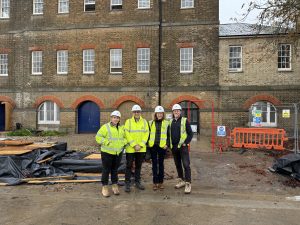
Reimagining Heritage: The Docking Station Transformation
The University of Kent’s Docking Station project has made headlines by securing a finalist position in the Construction Project of the Year 2025 category at the Kent Invicta Chamber Awards. This recognition goes beyond the physical construction of a facility; it celebrates a vision that blends historic preservation with cutting‑edge digital innovation, community participation, and academic‑industry partnership.
Why This Project Matters to Construction and Design Professionals
For practitioners in architecture, engineering, and project management, the Docking Station stands as a case study in balancing heritage constraints with contemporary requirements. The original Police Section House in Chatham is a Grade II listed building, which creates a regulatory environment that demands meticulous preservation of character and fabric. Yet the end use—a 3‑D production and immersive media hub—requires flexible floor plans, high‑intensity lighting, and sophisticated acoustics. The project demonstrates how to navigate these competing demands without compromising either side.
Managing Adaptive Reuse under Listing Regulations
Key to the success of the Docking Station is the team’s approach to adaptive reuse: keeping the external appearance and defining interior elements that provide contemporary function while preserving historic detailing. For example, the façade remains largely intact, but the interior has been reconfigured to accommodate motion‑capture rigs, LED volume sets, and photogrammetry workstations. Construction must follow stringent guidelines from the Historic England register, ensuring that any interventions are reversible and do not damage the original stonework.
Integrating Advanced Technical Infrastructure
Technological capability is the backbone of the Docking Station. The developers have commissioned state‑of‑the‑art audiovisual systems—including volumetric capture rigs and LED wall panels—that serve both student projects and commercial clients. These installations demand robust electrical, HVAC, and acoustic systems, prompting the project team to adopt modular, scalable solutions that can evolve as technology advances.
Funding and Partnerships: A Multi‑Sector Collaboration
The Docking Station’s funding showcases a model for resource mobilisation that can be mirrored in future projects. The National Lottery Heritage Fund has awarded £250,000, while additional support comes from the Arts Council England, the Ministry of Housing, Communities and Local Government, and the Colyer Fergusson Charitable Trust. The University’s Institute of Cultural and Creative Industries leads the project, backed by a consortium that includes design students, local businesses, and community volunteers.
Community Engagement through the ‘Make Your Mark’ Campaign
Community involvement is woven into every phase of the project. The ‘Make Your Mark’ initiative enabled local residents to contribute ideas and, in some cases, to donate funds. By engaging non‑professional stakeholders early, the project fosters a sense of ownership that can translate into sustained usage and support for the facility.
The Impact on Medway’s Economic and Cultural Landscape
Docking Station promises to become a catalyst for innovation in Medway and surrounding areas. By offering a shared workspace, production studios, and exhibition spaces, it offers a platform where creative professionals can collaborate, experiment, and showcase work. This influx of creative activity can stimulate local economies through job creation, tourism, and increased demand for ancillary services such as catering, accommodation, and tech support.
Bridging Academia, Industry, and Community
The University of Kent’s vision is to create a hub where students, scholars, local artists, and corporate partners can co‑develop projects. The flexible teaching spaces and co‑working areas are designed to accommodate interdisciplinary workshops, mentorship programmes, and public events. The inclusion of performance and exhibition venues ensures that the space remains an open dialogue between academic research and commercial entrepreneurship.
What Professionals Can Learn from the Docking Station Approach
1. **Strategic Planning for Historic Conversions** – Early stakeholder mapping, preservation guidelines and flexibility in design layout are key to harmonising heritage and modern use.
2. **Harnessing Public‑Private Funding** – A diversified funding strategy that blends grants, charitable contributions, and government support can mitigate financial risk.
3. **Community‑Centred Design** – Engaging the local populace fosters long‑term use and support, reducing the risk of under‑utilised facilities.
4. **Future‑Proofing Technical Infrastructure** – Investing in modular and scalable tech solutions ensures longevity and adaptability to rapid digital evolution.
Looking Ahead: The Second Phase and Beyond
The first phase, handled by Baxall Construction, has seen the Police Section House converted into studio and co‑working spaces. The second phase will introduce a new building behind the original structure, expanding capacity for research labs, collaborative studios, and additional community rooms. Completion of this phase is slated for late 2026, aligning with the grand opening of the photography exhibition by Medway School of Arts students.
Anticipated Milestones
- Mid‑2025: Finalise design concepts for the new building.
- Early 2026: Commence construction of the expansion.
- Late 2026: Inauguration of the full Docking Station complex.
- 2027 onwards: Regular schedule of workshops, exhibitions, and industry partnerships.
Action Steps for Stakeholders
For developers looking to model a similar project, consider the following initiatives:
- Conduct a feasibility study. Analyse heritage constraints, market demand for digital media spaces, and potential funding sources.
- Build a diverse consortium. Include architects, engineers, local artists, and commercial partners to cover all perspectives.
- Engage the community early. Use campaigns like ‘Make Your Mark’ to solicit input and foster support.
- Plan for technological adaptability. Specify modular infrastructure that allows for future upgrades.
- Document the process. Create case studies, photography exhibitions or academic papers to share best practice.
By following these steps, project leaders can create spaces that respect heritage, serve contemporary needs, and generate long‑term value for both their institutions and the surrounding community.
Contact and Further Information
To learn more about the Docking Station project, inquire about potential collaborations, or explore how similar projects can benefit your organisation, visit the project page or email the university team.
Connect with the University of Kent
Stay updated with the latest developments by following our social media channels and subscribing to our newsletters.
Next Steps: Engage With the Community
We invite you to watch the upcoming opening ceremony at Westenhanger Castle in Hythe on 20 November. The event will showcase the Docking Station’s potential to influence digital media innovation in the region. After the ceremony, stakeholders can propose joint projects, workshops, or educational programmes to maximise the impact of the new facility.
Take the next step: Schedule a visit to the campus and experience the Docking Station’s potential firsthand.
Final Thoughts
The Docking Station demonstrates that heritage buildings can be reimagined as hubs for modern creativity, provided that we align preservation ethics with technological ambition and community involvement. Its success offers a replicable model for universities, municipalities, and private developers aiming to make their built environment work harder for tomorrow’s innovations.
For more insights into architectural trends, digital media integration, and heritage conservation strategies, visit the University of Kent research portal and explore related publications.
We encourage you to share your thoughts and experiences. If you have worked on similar projects, contact us or leave a comment on our news page.

